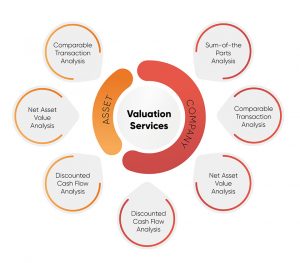
Table of Contents
Understanding Valuation Approaches and Key Valuation Metrics for Business Valuation
Accurate business valuation is a fundamental aspect of decision-making for mergers and acquisitions, financial reporting, tax compliance, fundraising, marital divorce dispute and litigation. It involves estimating a company’s worth using structured approaches and key metrics tailored to its operations and industry. This article explores the main valuation approaches, essential metrics, and valuation multiples used by professionals to assess a business’s value.
Key Valuation Approaches
Valuation professionals common rely on three widely recognized approaches to determine the value of a business:
1. Income Approach
The Income Approach focuses on the present value of future potential earnings expected to be generated by a business. It’s best suited for companies with predictable cash flows and growth trajectories. The commonly used income methods are:
– Discounted Cash Flow (DCF) Method: The DCF method estimates the value of a business by projecting future cash flows and discounting them back to present value using a discount rate (e.g., the Weighted Average Cost of Capital – WACC). The discount rate used reflects the business risks and the time value of money. This DCF method captures the intrinsic value of the business and accounts for specific risk factors.
– Residual Income Model: This method evaluates the net income generated after deducting the cost of equity, particularly useful for companies with significant intangible assets or fluctuating profitability.
2. Market Approach
The Market Approach derives value from market data, comparing the target business to similar publicly traded companies or past transactions involving similar firms.
– Comparable Company Analysis (CCA): This method involves identifying public traded companies that are similar to the target business in terms of size, industry and financial performance. Using valuation multiples (e.g., EV/EBITDA, P/E), this method identifies comparable companies based on size, industry, and financial metrics. Valuation multiples (e.g. EV/EBITDA, EV/Revenue) derived from these comparable companies are then applied to the target company’s financial metrics to estimate its fair value.
– Precedent Transaction Analysis (PTA): Focused on historical transactions involving businesses similar to the target company. This method is particularly useful for M&A scenarios as it reflects the premiums or discounts paid in real world transactions based on deal size, industry trends, market conditions and transaction motivations.
3. Asset-Based Approach
The Asset-Based Approach calculates value based on the fair market value of assets and liabilities, making it suitable for asset-intensive businesses or liquidation scenarios.
– Book Value Method: Relies on the values recorded on the balance sheet. This method normally derives the lowest value for a business.
– Adjusted Net Asset Method: This method adjusts for fair market values of the business on the balance sheet, often including intangible assets or contingent liabilities.
– Liquidation Value: Assesses orderly and forced liquidation outcomes, particularly in distressed situations.
Valuation Metrics and Multiples
Valuation multiples provide relative benchmarks for assessing a business’s valuation, simplifying the comparison across similar companies. Below are some commonly used key metrics and their applications:
Revenue Multiples
– Enterprise Value (EV) / Revenue: Used for early-stage companies such as start ups or industries prioritizing market share over profitability, such as technology and SaaS.
Earnings Multiples
– Price-to-Earnings (P/E): This metrics are ideal for companies with stable and consistent earnings, representing the relationship between a company’s stock price and its earnings per share. It suggests how much an investor is willing to pay for each dollar of earnings. A high P/E ratio may suggest strong future growth potentials, while a low P/E ratio could indicate undervaluation or challenges.
– EV / EBITDA: A widely used multiple that normalizes differences in capital structure and depreciation. This method is useful to compare companies with different debt levels.
– EV / EBIT: Incorporates depreciation and amortization, making it useful for asset-heavy industries.
– PEG Ratio: A refinement of the P/E ratio that incorporates expected growth rates.
Cash Flow Multiples
– EV / Free Cash Flow (FCF): This method evaluates a company’s value based on the target company’s ability to generate cash after accounting for capital expenditures.
Industry-Specific Multiples
Certain industries require unique metrics to reflect their operating characteristics such as:
– EV / Subscribers (Telecom)
– EV / Barrels of Oil Equivalent (BOE) (Energy)
– EV / Gross Merchandise Value (GMV) (E-commerce)
Critical Metrics in Valuation
Beyond multiples, the following metrics provide essential insights into a business’s financial health and risk profile:
- Revenue Growth Rate: Reflects the company’s scalability and market expansion.
- Profit Margins: Key indicators include gross profit margin, EBITDA margin, EBIT margin and net profit margin.
- Return on Equity (ROE): Measures how effectively the company generates shareholder returns.
- Debt-to-Equity Ratio: Assesses financial leverage and risk.
- Working Capital: Evaluates short-term liquidity and operational efficiency.
Choosing the Right Approach
The selection of a valuation approach depends on several factors, including the business type, industry that the target company is in which stage of its business cycle (e.g. growth / mature / declining stage), and valuation purpose. For example:
– A tech startup may require the DCF method and EV/Revenue multiple.
– A mature manufacturing company might rely on EV/EBITDA or P/E multiples.
– An capital intensive real estate development / banking business could benefit from the Asset-Based Approach.
Final Thoughts
Valuation is both an art and a science, blending rigorous analysis with professional judgment. By combining the appropriate approach with industry knowledge and advanced financial modeling, valuers can provide reliable and actionable insights.
If you need expert assistance with business valuation, impairment reviews, or purchase price allocation (PPA), our team of valuation expert offers tailored solutions to meet your needs.
Contact Us
If you need help in knowing how our services can help you in discovering the fair value for your business you want to sell or the target company you intend to buy, please do not hesitate to contact us via whatsapp or email to us directly.